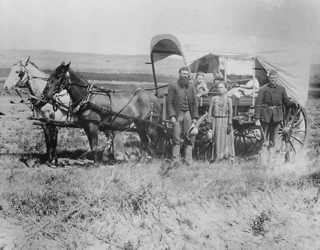
A prisoner of war (POW) is a person who is held captive by a belligerent power during or immediately after an armed conflict. The earliest recorded usage of the phrase "prisoner of war" dates back to 1610.

Atlanta is a village in Phelps County, Nebraska, United States. The population was 131 at the 2010 Census. During World War II, the town was neighbored by Camp Atlanta, which housed more than 3,000 Nazi German prisoners of war over three years. The camp was said to house more prisoners during the war than the town had in population during its entire existence.
Marlag und Milag Nord was a Second World War German prisoner-of-war camp complex for men of the British and Canadian Merchant Navy and Royal Navy. It was located around the village of Westertimke, about 30 km (19 mi) north-east of Bremen, though in some sources the camp's location is given as Tarmstedt, a larger village about 4 km (2.5 mi) to the west. There were also American merchant seamen detained here as well as some U.S. Navy personnel.
Camp Albuquerque was an American World War II POW camp in Albuquerque, New Mexico that housed Italian and German prisoners of war. From this branch camp, the POWs did mostly farm labor, from 1943 to 1946. Most of these POWs were transferred from Camp Roswell, which was a base or main POW camp for New Mexico. Camp Lordsburg, New Mexico, and Camp El Paso, Texas, were also base camps.

Stalag VIII-A was a German World War II prisoner-of-war camp, located just to the south of the town of Görlitz in Lower Silesia, east of the River Neisse. The location of the camp lies in today's Polish town of Zgorzelec, which lies over the river from Görlitz.

Stalag IV-B was one of the largest prisoner-of-war camps in Germany during World War II. Stalag is an abbreviation of the German Stammlager. It was located 8 km (5.0 mi) north-east of the town of Mühlberg in the Prussian Province of Saxony, just east of the Elbe river and about 30 mi (48 km) north of Dresden. From 1944 to 1945 it belonged to the Province of Halle-Merseburg. Now, the area is in Brandenburg. A sub-camp, sometimes identified as Stalag IV-B/Z,Stalag 304 or Stalag IV-H was located at Zeithain, 10 km (6.2 mi) to the south in Saxony.

Windfall Indiana World War II POW Camp was a World War II German prisoner-of-war camp from 1944 to 1945 in Windfall, Indiana, United States. The camp was located near the site of the Windfall High School. The location, on the northeast side of town, is now home to a mobile home community. At its peak the camp housed 1,500 German prisoners and their prison officers. The prisoners were put to work laboring on local farms.

Camp Concordia was a prisoner-of-war camp that operated from 1943–1945. Its location is two miles north and one mile east of Concordia, Kansas. The camp was used primarily for German Army prisoners during World War II who were captured in battles that took place in Africa.

The history of the U.S. state of Nebraska dates back to its formation as a territory by the Kansas–Nebraska Act, passed by the United States Congress on May 30, 1854. The Nebraska Territory was settled extensively under the Homestead Act of 1862 during the 1860s, and in 1867 was admitted to the Union as the 37th U.S. state. The Plains Indians are the descendants of a long line of succeeding cultures of indigenous peoples in Nebraska who occupied the area for thousands of years before European arrival and continue to do so today.

By the end of World War II, the number of Romanian prisoners of war in the Soviet Union was significant. Up to 100,000 Romanian soldiers were disarmed and taken prisoner by the Red Army after the Royal coup d'état of August 23, 1944, when Romania switched its alliance from the Axis Powers to the Allies. Before that date, almost 165,000 Romanian soldiers were reported missing, with most of them assumed to be POWs. Soviet authorities generally used prisoners of war as a work force in various labor camps.
Camp Rupert was a World War II prisoner of war camp in the western United States, located in Minidoka County, Idaho, west of Paul. It was built for $1.5 million, which was everything needed for a city of 3,000: barracks, water, sewer, and a hospital. The first POWs were Italian and were received in May 1944, and 500 German POWs arrived that September.

Stalag XXI-D was a German World War II prisoner-of-war camp based in Poznań in German-occupied Poland, operated in 1940–1945. It held Polish, French, British, Belgian, Dutch, Serbian, Soviet and Italian POWs.

Members of the German military were interned as prisoners of war in the United States during World War I and World War II. In all, 425,000 German prisoners lived in 700 camps throughout the United States during World War II.

The Palawan massacre occurred on 14 December 1944, during World War II, near the city of Puerto Princesa in the Philippine province of Palawan. Allied soldiers, imprisoned near the city, were killed by Imperial Japanese soldiers. Only eleven men managed to survive.

Szebnie was a forced-labor camp established during World War II by Nazi Germany in the General Government in the south-eastern part of occupied Poland. It was located near the town of Szebnie approximately 10 kilometres (6 mi) east of Jasło and 42 km (26 mi) south-west of Rzeszów. The facility was constructed in 1940 originally as horse stables for the Wehrmacht, adjacent to a manorial estate where the German officers stationed (photo). Over the course of the camp's operation thousands of people perished there, including Soviet prisoners of war, Polish Jews, Poles, Ukrainians, and Romani people. The charred remains of the camp were entered by the Soviets on 8 September 1944.
The Italian Service Units or ISUs were military units composed of Italian prisoners of war (POWs) that served with the Allies during World War II against Nazi Germany and the Empire of Japan from May 1944 to October 1945. The armed forces of the United States captured many Italian soldiers during the North African campaign Operation Torch, which started in November 1942 and sent 51,000 of them to the United States. After the signing of the armistice by the Badoglio government in Italy on September 8, 1943, and with Pietro Badoglio and the Kingdom of the South officially declaring war on Nazi Germany on October 13, 1943, the Americans began to see the POWs as potential allies. The capture of Rome by the Allies on June 4, 1944, motivated many POWs to change sides. About 90% joined Italian Service Units, which operated in the United States and overseas.

During World War II, Utah held 15,000 prisoners of war. These prisoners were predominately German and Italian, and they were spread out over 12 different camps over the course of two years. Utah's terrain of mountains and desert, as well as its isolated and inland position, made it an ideal place for housing POWs. Camps in Salina, Tooele, and Ogden held the most soldiers. Camp Salina is especially notable for the massacre that occurred July 8, 1945. Prisoners provided much of the agricultural labor throughout Utah during the war, allowing them to form special bonds with the community that weren't traditionally seen elsewhere in the country.

During the German invasion of Poland, which started World War II, Nazi Germany carried out a number of atrocities involving Polish prisoners of war (POWs). During that period, the Wehrmacht is estimated to have mass murdered at least 3,000 Polish POWs, with the largest atrocities being the Ciepielów massacre of 8 September 1939 and the Zambrów massacre of 13–14 September. Most of those atrocities are classified as war crimes of the Wehrmacht. Jewish soldiers with the Polish Army were also more likely than others to be victims of various atrocities.















